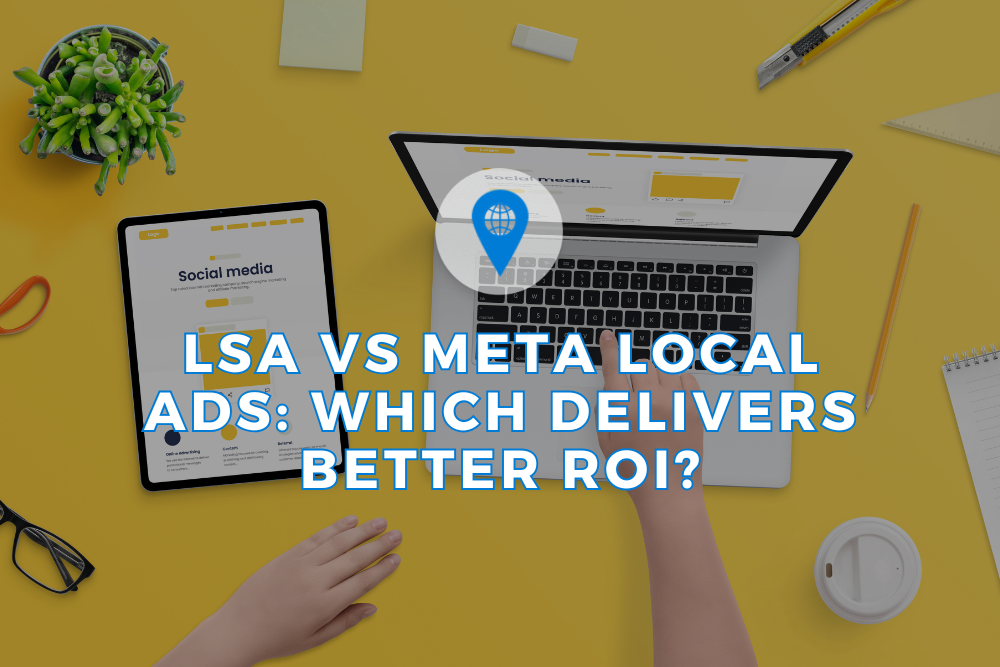LSA vs Meta Local Ads: Which Delivers Better ROI?
- Published: October 06, 2025

If you’re running a local service business, you’ve probably wondered where to invest your marketing dollars for the best return: Google Local Services Ads (LSAs) or Meta Local Ads (Facebook & Instagram Ads).
Both platforms can drive local leads—but they work in very different ways. And depending on your service, budget, and market, one can outperform the other dramatically.
In this post, we’ll break down how LSAs compare to Meta Local Ads in terms of cost, targeting, lead quality, and ROI—and help you decide which platform delivers the best value for your business.
What Are Google Local Services Ads (LSAs)?
LSAs are Google’s pay-per-lead advertising platform designed specifically for local service providers. They appear at the top of search results, even above Google Ads and the local map pack.
Key features:
- Pay-per-lead model (you only pay when a customer contacts you)
- Google Guaranteed or Screened badge builds trust
- Leads come via call, message, or direct booking
- Service area and job type–based targeting
- Integrated with your Google Business Profile
What Are Meta Local Ads?
Meta Local Ads refer to location-targeted ads on Facebook and Instagram. These use Meta’s powerful audience targeting tools to deliver visual ads to users in specific locations or with certain demographics.
Key features:
- Pay-per-click or pay-per-impression model
- Strong visual and storytelling formats (images, video, carousels)
- Advanced demographic and interest targeting
- Useful for branding, awareness, and retargeting
- Can drive leads via forms, Messenger, website visits, or calls
Comparing LSA vs Meta Local Ads
Let’s dive into a head-to-head comparison across the key dimensions that matter most for local service businesses:
1. Lead Quality
LSA:
- Captures high-intent leads—users searching for your exact service (“emergency plumber near me”)
- Customers are ready to book
- Typically higher conversion rates
Meta:
- Interruption-based advertising (users are scrolling, not searching)
- Leads may be curious, but not always ready to hire
- Lower lead quality unless paired with aggressive follow-up
Winner: LSA for bottom-of-funnel lead generation
2. Cost Per Lead (CPL)
LSA:
- You pay only for valid leads
- CPL varies by vertical and location ($15–$100+ depending on service type)
- You can dispute bad leads (wrong numbers, spam, etc.)
Meta:
- Lower initial cost per click ($1–$5 average)
- CPL depends on conversion strategy—can be very low or very high
- You pay for clicks or impressions, not guaranteed inquiries
Winner: Depends on industry
- LSA: Higher CPL, but better lead intent
- Meta: Lower CPL, but more nurturing required
3. Ad Placement and Visibility
LSA:
- Appears at the top of Google Search results
- Includes Google badge, star rating, and service area info
- Gets high click-through rates from service-focused searches
Meta:
- Ads appear in newsfeeds, stories, reels, and Messenger
- Highly visual and engaging
- Better for brand awareness, storytelling, or promotions
Winner:
- LSA wins for direct search intent
- Meta wins for visual-first or promotional campaigns
4. Setup and Optimization Complexity
LSA:
- Requires business verification, licenses, insurance, and background checks
- Job types and service areas must be configured
- Simpler campaign management—less daily tweaking
Meta:
- Requires strong creative assets (images, video, copy)
- Involves targeting setup, pixel installation, split testing
- More time-intensive optimization process
Winner: LSA is easier to maintain once set up
Meta requires more ongoing creative and targeting management
5. Branding and Retargeting Power
LSA:
- Great for capturing demand—but not built for storytelling or brand building
- No retargeting features or custom audience tools
Meta:
- Excellent for retargeting website visitors or past leads
- Great for staying top-of-mind with prospects
- Ideal for seasonal promos, offers, and brand awareness
Winner: Meta wins for branding and multi-touch journeys
6. Industries That Perform Best on Each Platform
LSA Is Ideal For:
- Emergency services (plumbing, HVAC, electrical)
- High-trust home services (roofing, pest control, restoration)
- Legal, dental, real estate, and financial services
- Any industry with urgent “near me” searches
Meta Works Best For:
- Visual or lifestyle-based services (remodeling, medspas, landscaping)
- Promotional services (seasonal deals, first-time discounts)
- Brand-centric local businesses (fitness studios, clinics, salons)
Retargeting people who already visited your site
So Which Delivers Better ROI?
| Goal | Best Platform |
| Immediate lead generation | LSA |
| Long-term brand awareness | Meta |
| Retargeting site visitors | Meta |
| Low-effort lead capture | LSA |
| Creative storytelling | Meta |
| Emergency services | LSA |
| Promotional campaigns | Meta |
Pro Tip: Use Both Together for Maximum Impact
Smart local businesses use LSA for high-intent leads and Meta for visibility, remarketing, and nurturing.
Here’s a simple example strategy:
- Run LSA ads for “plumber near me” or “roof leak repair”
- Retarget website visitors with Meta ads offering a seasonal promo
- Build a review funnel that fuels both platforms
Final Thoughts: Choose Based on Intent, Not Just Price
Google LSAs and Meta Local Ads each offer strong ROI—but in very different ways. LSAs win on immediate conversion, while Meta excels at visibility, engagement, and long-term brand growth.
The best approach? Don’t choose one over the other. Choose based on your sales funnel, service type, and marketing goals.
Need Help Optimizing Your Local Ad Strategy?
At Local View, we specialize in building multi-channel local ad campaigns that combine LSA, Meta, GBP, and organic strategies to maximize your ROI.
Whether you want more calls this week or a long-term brand presence in your community, we’ll build a plan that works for your business.
